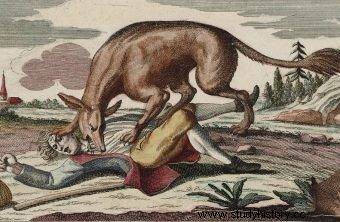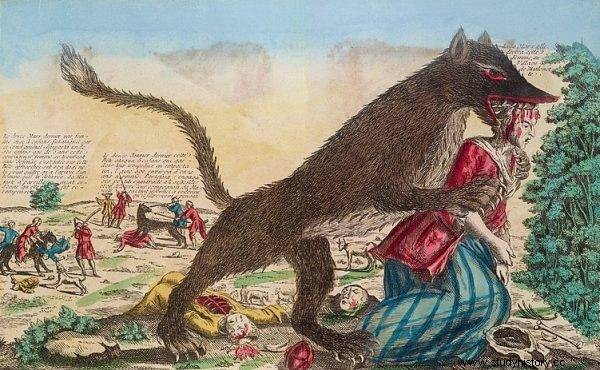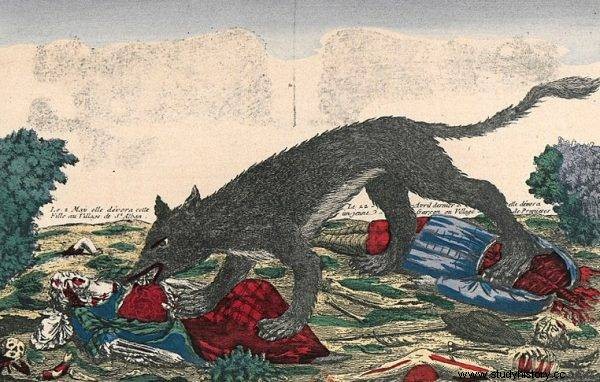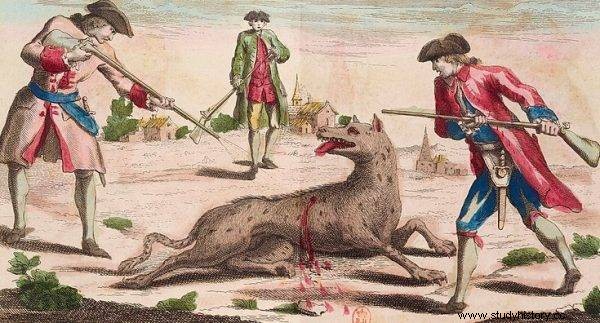In the 18th century, a mysterious creature spread terror in the small province of Gévaudan in the south of France. Cryptosoolologists who study animals in legends and myths classify them as cryptids - hypothetical creatures. But what could the bloodthirsty beast really be?
The attacks began in the mountainous terrain of Mont Mouchet. Between 1764 and 1767, the beast appeared more than 200 times. Its victims were mainly women and children. Some remained crippled for the rest of their lives.
"Big Wolf" roaming the hills
It was a warm June day in 1764 in Langogne. Cows were grazed in the surrounding meadow; A young girl was taking care of the animals. Suddenly, a strange creature emerged from a nearby forest. The dogs accompanying the shepherdess ran away in fear, she failed. She did, however, survive the attack; the cattle swarming around her saved her. When she reached the village in tattered clothes, no one wanted to believe her, especially since the beast she was describing resembled a large wolf.

In the 18th century, a mysterious creature was a terror in the small province of Gévaudan in the south of France.
At the end of the month, a 14-year-old girl from the village of Saint-Étienne-de-Lugdarès fell victim to another attack. She was not lucky. Her torn body was found by the inhabitants of a nearby village. The summer of 1764 was full of attacks and more dead, dismembered human bodies.

The summer of 1764 was full of beast attacks.
The fear that fell on the local population is difficult to describe. An army was delegated to areas where a strange and dangerous creature existed. They wanted to kill the "big wolf" roaming the hills as quickly as possible. After tracking down and killing a very large specimen of this species, everyone breathed a sigh of relief; they thought the nightmare was over. In the weeks that followed, however, more dismembered bodies of the local residents appeared. Scalped heads and half-eaten corpses were found. The beast did not forget about itself.
Neither is a bear nor a monkey
The attacks carried out by the mysterious cryptid focused mainly on women and children. Was the beast afraid of fighting strong and tall men? As one would-be victim described immediately after meeting the bloodthirsty creature:
(...) is not a wolf, his mouth is always open, his ears are short and straight, his chest is white and wide, the tail is very long and strong, the hind legs are large and long, with hooves like horses. The front feet are shorter and covered with long hair. There are 6 claws in each paw.
There is no wild animal around from which [the beast] could be born. Since it is similar to a wolf and somewhat to a bear, it could arise from a combination of a bear and a she-wolf (...) . But it might as well be a great ape, because when it crosses a river it rises on its hind legs and wades like a human does.

The beast was supposed to attack mainly women and children. Was she afraid of confronting large men?
Children and women were forbidden to be alone in pastures, meadows and near forests. Local hunters regularly combed the wooded hills. They tried to end the panic in the area. Unsuccessfully. People feared for their lives.
Finally, in October and November 1764, a few hunters tracked down the monster in the forest. They fired shots at the great figure, which reportedly fell to the ground, then got up and ran quickly into the trees. There were several such meetings with the mysterious creature. Although it seemed to the hunters every time that the beast had received fatal wounds, the attacks continued after them. It was also useless to set up death traps.
Great werewolf hunt
The terror in Gévaudan continued. People who managed to survive the encounter with the cryptid struggled with mental problems. The mysterious monster also attacked animals (but much less frequently than humans!). Famine fell on the provinces. Inhabitants of the vicinity were afraid to leave their homes; they neglected their jobs, making them unable to support themselves and feed their families.
It is not surprising that in such conditions the creature began to be mythologized - supernatural abilities were attributed to it. The church only exacerbated the growing paranoia as it informed the faithful that the beast was the punishment for their sins and came straight from the depths of hell. Many people even thought that the monster roaming around is… a werewolf. They claimed to hear him singing and laughing in the pastures at night. In addition, several eyewitnesses spoke of the buttons on the beast's belly - did she have a specially sewn outfit? Skeptics tried to explain the presence of buttons with the nipples on the monster's body.

Many people even thought that the monster roaming around is… a werewolf.
Attacks happened more and more often, sometimes even in distant places. It has been suspected that there are several beasts. In addition to typically supernatural stories about a mysterious creature, rational theories were also developed - the monster was to be a wild hyena, panther, lion, and even a tiger.
The great hunt has begun. The king promised a hefty compensation for killing the bloodthirsty creature (his body would later be exposed to the court). Bounty hunters came to the surrounding villages encouraged by the prospect of wealth and fame. In the end, the inhabitants were fed up with the constant flow of strangers, because feeding them and providing them with accommodation was becoming a chore.
Meanwhile, a Norman nobleman, the great hunter Jean-Charles Marc Denneval, came to Gévaudan by order of Louis XV. During his month-long stay, he only stated that, according to him, the beast was not a wolf. Unfortunately, the number of victims was constantly increasing, so in the wake of Denneval, more hunters (Antoine de Beauterne, François Antoine) were sent, because the situation in Gévaudan was made loud in European courts and the powerless king was mad with anger.
From zero to hero
At this point, Jean Chastel entered the scene. He was a figure not very liked by the local population. He dealt mainly with poaching, which often fell into the hands of the judiciary. However, his contacts with high-ranking residents (e.g. with the Marquis d'Apcher) allowed him to avoid more serious problems with the law.
His sons - Pierre and Antoine - risked the lives of two people during one of the beast hunts. Those nobles tracked down the monster, but as they lined up to shoot at the edge of the cliff, the Chastel brothers ... pushed them over the edge. The injured fell into a narrow ravine a few meters below. The perpetrators of the misconduct were immediately caught and arrested. While they were in prison, not a single attack was recorded…

The beast fell dead. Her body was ordered to be embalmed and taken to the surrounding towns, and Jean Chastel became a hero who freed the local people from fear.
The aforementioned Marquis d'Apcher stood up for the would-be killers, so they were soon released. And the attacks started all over again. The local people had suspected the Chastels for some time - now they were almost sure. Full of hate, they have destroyed the property belonging to the alleged attackers.
Meanwhile, the Marquess d'Apcher organized the last great beast hunt, attended by none other than Jean Chastel. What's more - played the most important role in it! He prepared special silver balls (previously blessed). In a clearing near the village of Saugues, he knelt down and began reading the Bible aloud. Unexpectedly, the monster came out of the forest and… stopped.
He watched Chastel calmly. He didn't panic, put the book down, aimed the gun, then fired a shot. The beast fell dead. Her body was ordered to be embalmed and transported to nearby towns, and the hunter became a hero who freed the local population from fear. He even went to Versailles with the slaughtered beast, but by the time he got there, the monster's corpse began to decompose. Louis XV ordered the body to be buried.
A real beast
Over the years, various theories have arisen trying to answer the question:what exactly was the beast that spreads terror? It is strange that she was so good at hiding from people; she knew exactly when to hide and when to attack (the area was full of mine shafts and was ideal for shelter). In addition to the hypothesis about the monster's supernatural lineage, two are the most popular - the psychopathic murderer who disguised his dark desires, or the animals trained to kill people.
The latter is more likely. There are several facts for this. In those days it was fashionable to have a menagerie that kept wild and exotic animals. The Chastels maintained such a "zoo" on their property. Moreover, they had great contacts with African merchants who dealt in the trade of "exhibits". In the "collections" of the Chastel brothers there was even a hyena, considered a mythical creature (hardly anyone knew what it looked like then).
Was she the one who was the terror of Gévaudan? She made an impression on the witnesses, her mottled fur could be mistaken for the aforementioned buttons, and the sounds could be taken for laughter or singing. The strange behavior of the beasts with the Chastels is also puzzling - instead of attacking, she was staring at them, and even had to wag her tail as if she recognized them. There was even an explanation for the fact that many attempts to kill the monster ended with his escape into the forest. The animal was to have a special hard leather armor to protect it from bullets. The truth, as always, turns out to be less sensational than fantastic stories.
